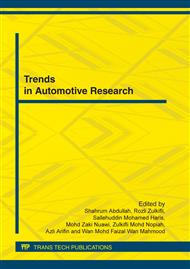p.224
p.232
p.237
p.242
p.247
p.252
p.260
p.265
p.270
Impact Performance of Low Carbon Steel Safety Beams for Car Doors
Abstract:
This paper presents impact behaviour and energy absorption response of car door safety beams. Low carbon steel of thickness 2.25 mm, designed into four different shapes of, tube-beam, I-beam and II-beam were used in this experiment to study the effect of impact load on the crash characteristic of the door beams in terms of load bearing and attenuation of energy. The tube-beam is the conventional beam commonly used in cars today. The reason propelling the investigation of other beams is to draw a parallel comparison with the conventional tube beam and possibly obtain an optimised design in terms of impact absorption capability. Masses of impactors used in the impact load simulations were 10 kg, 20 kg, 30 kg, 40 kg and 50 kg at an impact speed of 30 km/h. Analysis were carried out on all samples focusing on energy absorption and deformation characteristics of the beam structures using Pam CrashTM finite element analysis software. Results from this studies indicated that the II-beam design is better than the other beams in terms of the energy absorption and deformation. The proposed II-beam design may be able to prolong the useful life of passenger car door.
Info:
Periodical:
Pages:
247-251
Citation:
Online since:
April 2012
Price:
Сopyright:
© 2012 Trans Tech Publications Ltd. All Rights Reserved
Share:
Citation:


